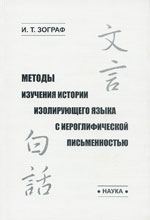|
|
| |

|

|
Zograph I.T. Methods of Historical Study of an Isolating Language with Hieroglyphic System of Writing. St Petersburg, Peterburgskoe Vostokovedenie 2008. 223 p.
SUMMARY
Languages like Chinese are known to be practically devoid of morphology in the traditional sense of the word. They instead mostly rely on word order and auxiliary/function words to mark syntactic relations within the sentence. In such languages function words play a part comparable to that of inflection in flexional languages. Therefore, in dealing with any historical description of the Chinese language, special emphasis should be laid on the study of semantic and formal properties of each function word within the framework of the grammatical system of the language.
Function words, also known as empty words, include, in fact, not only purely auxiliary elements (conjunctions, modal particles and the like), but also “semi-auxiliary” ones (copula words, pronouns and other substitutive words). It is function words that tend to undergo most noticeable alterations in the course of time and generally account for linguistic similarities or discrepancies between individual literary monuments. The inventory of function words had markedly changed by the time Old Chinese gave way to Middle Chinese: considerable variations on the function-word list have equally accompanied the transition from Middle Chinese to the current language.
In these changes the following phenomena can be observed: 1) a function word is supplanted by another with very close grammatical idea; 2) the “material” (surface) shape of a word is preserved, with the function changing fully or partly.
By picking out the “active” inventory of function words, ascertaining their actual roles and thus fixing the peculiarities of syntax we can provide ourselves with a basis for characterizing any variant of Chinese on any stage of its development, in spite of the fact that each variant sets its own specific requirements.
One example can be found in studying the forming of Baihua as a literary language based on a vernacular, in which case the following two points become of primary importance: firstly, texts chosen for the study must be as close in their style to colloquial speech of any of the periods under consideration as possible (at the same time bearing in mind the parallel existence of Wenyan with its influence on Baihua), and secondly, the texts representing each period should be classified according to certain literary genres (in Middle Chinese, the features of a literary monument language have been to an extent determined
by its genre).
The Yuan epoch, moreover, poses a problem of language interference due to the interaction between Chinese and Mongolian.
Analyzing Wenyan, the literary language derived from the norms of Ancient Chinese, provides yet another situation, because much of attention is in this case focused on the shifts appearing in different historical periods in grammatical value of both Ancient Chinese function words and Ancient Chinese syntactic structures.
The monography is mainly of methodological character and the seemingly separate sections of the book are a kind of illustrations given to the problems discussed, supplied with a thorough development of the main ideas which are briefly mentioned in the Introduction. The factual material for the monography has been drawn both from the author's previous works (with a very low circulation) and from entirely new data published for the first time.
The sections of the book are: Language in Dynamics; Baihua and Dung Huang Texts; Baihua and Confucian Yui-lu of the Sung Dynasty; Local Differences in the Language of the Monuments of Medieval Chinese Literature; Wenyan and its Interaction with Baihua; Genre Peculiarities in the Language of Medieval Chinese Texts; The Yuan Epoch - the Linguistic Situation in China; Interlevel Linguistic Relations and Linguistic Interference; Conclusion - Medieval Baihua and Modern Chinese.
 PDF-files PDF-files
Аннотация, Вместо предисловия, Summary, Содержание
Keywords
Baihua
hieroglyphic system
isolating languages
|
|
|
|
Random news: Announcements |
|
The Annual IOM Academic Session “The Written Heritage of the Orient as the Basis for Classical Tradition of Oriental Studies” will be held on December 2–4, 2024. The program is now available. |
|
Read more...
|
|
|
|
|

